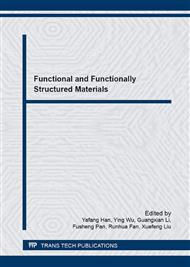[1]
M. Hansan, J.F. Rohan., Cu electrodeposition from methanesulfonate electrolytes for ULSI and MEMS applications J. Electrochem Soc., 157(2010) D278-D282.
DOI: 10.1149/1.3332729
Google Scholar
[2]
S. Vaidya et al., Line width Dependence of electromigration in Evaporated Al-0. 5Cu , Appl. Phys. Lett. Vol. 36, (1980), p.464. -468.
Google Scholar
[3]
Lanford W. A., Ding. P. J., Wang W., Hymes S., Murarka S. P. Alloying of copper for use in microelectronic metallization. Mater. Chem. Phys., 1995, 41 (3): 192-198.
DOI: 10.1016/0254-0584(95)01513-2
Google Scholar
[4]
Hu C. -K., Rodbell K. P., Sullivan T. D., Lee K. Y., Bouldin D. P., Electro-migration and stress induced voiding in fine AI and AI-alloy thin-film lines. IBM J. RES. DEVELOP, 1995, 39 (4): 465-497.
DOI: 10.1147/rd.394.0465
Google Scholar
[5]
Attardo M. J., Rosenberg R. Electro-migration damage in Aluminum film conductors. J. Appl. Phys., 1970, 41 (6): 2381-2386.
DOI: 10.1063/1.1659233
Google Scholar
[6]
Gangulee A, D'heurle F. M. H. F. M. Effects of alloy additions on electro-migration failure in thin Al films. Appl. Phys. Lett., 1971, 19 (3): 76-77.
Google Scholar
[7]
Blatt F. J. Physics of electronic conduction in solids. McGraw-Hill, New York, (1968).
Google Scholar
[8]
Yousuke Koike, Inase T., Takayama S. J. Temperature Dependence of Internal Stress and Crystal Growth of Dilute Cu Alloy Films. Solid State Phenomena, 2007, 127: 147-152.
DOI: 10.4028/www.scientific.net/ssp.127.147
Google Scholar
[9]
Y. K. Ko, Jang. H. J., Lee S., Yang H. J., Lee W. H., Reucroft P. J., Lee J. G., Effects of molybdenum, silver dopants and a titanium substrate layer on copper film metallization. J. Mater. Sci. 2003, 38: 217-222.
Google Scholar
[10]
Gungor A., Barmak K., Rollett A. D., Cabral Jr C., Harper J. M. E. Texture and resistivity of dilute binary Cu(Al), Cu(In), Cu(Ti), Cu(Nb), Cu(Ir), and Cu(W) allow thin films. J. Vac. Sci. Techno. B: Microelectronics and Nanometer Structures, 2002, 20 (6): 2314-2319.
DOI: 10.1116/1.1520549
Google Scholar
[11]
Barmak K., Cabral Jr C., K. P. Rodbell, Harper J. M. E. On the use of alloying elements for Cu interconnect applications. J. Vac. Sci. Technol., 2006, B(24): 2485-2498.
DOI: 10.1116/1.2357744
Google Scholar
[12]
J. Iijima, M. Haneda, J. Koike, Growth Behavior of Self-Formed Barrier Using Cu-Mn Alloys at 350 to 600 °C, IEEE. 6(2006) 155-157.
DOI: 10.1109/iitc.2006.1648675
Google Scholar


